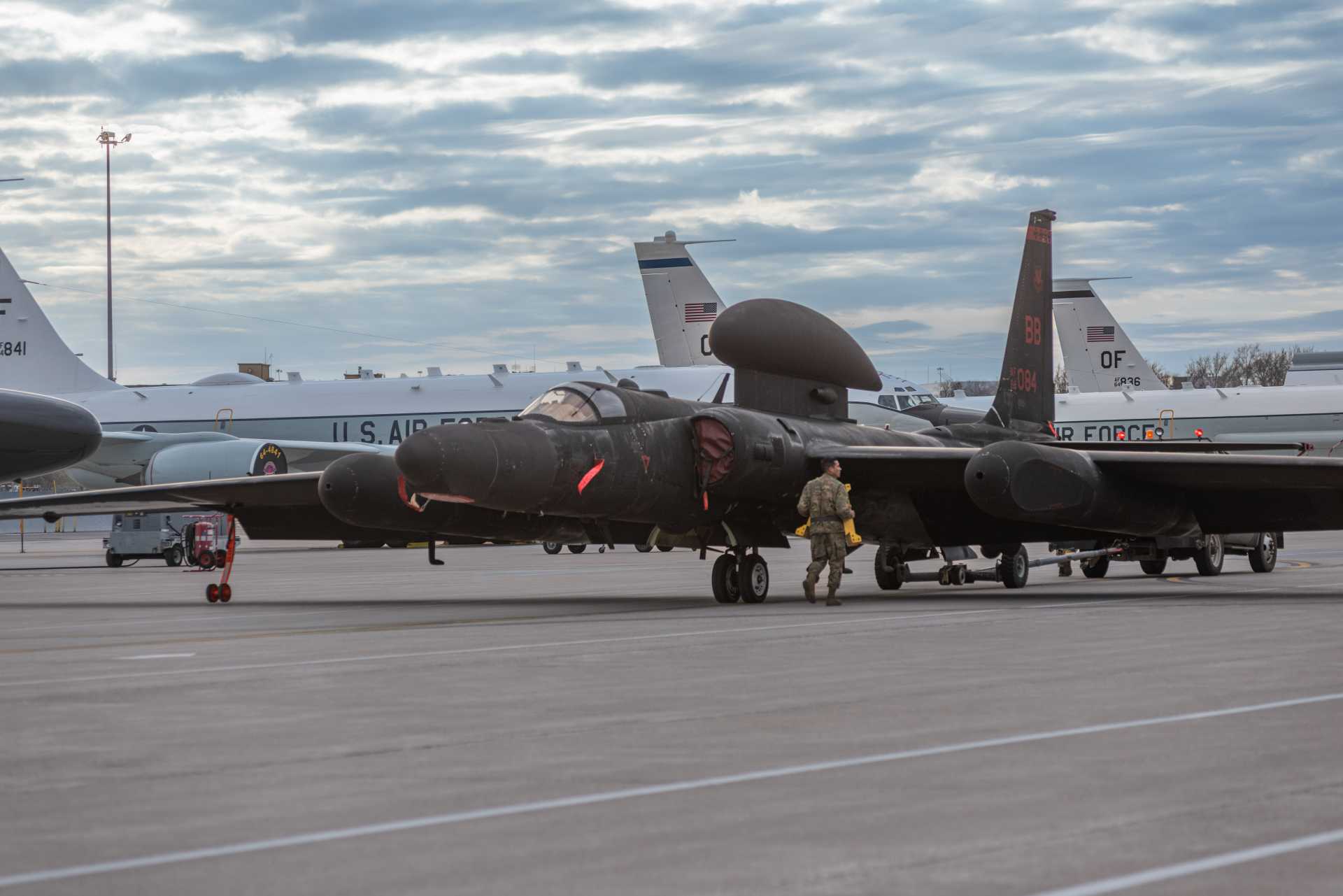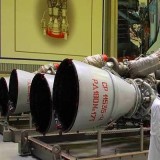Analysis: US U-2S Dragon Lady Aircraft Provides Ultimate Spy in the Sky Safeguarding Global Security

{loadposition bannertop}
{loadposition sidebarpub}
The U-2S Dragon Lady spy aircraft continues to exemplify the cutting edge of intelligence, surveillance, and reconnaissance (ISR) capabilities, providing unparalleled support to global security missions. This exclusive focus highlights how this iconic high-altitude reconnaissance aircraft remains a vital asset in modern military operations. From its inception to its continuous evolution, the U-2S demonstrates not only technological resilience but also adaptability, making it a crucial tool for ensuring information superiority in an era where data dominance is key to operational success.Follow Army Recognition on Google News at this link
US Air Force U-2S Dragon Lady on the ground, highlighting its iconic design and advanced capabilities as a high-altitude intelligence, surveillance, and reconnaissance aircraft. (Picture source: U.S. DoD)
Renowned for its exceptional ISR (of Intelligence, Surveillance, and Reconnaissance) capabilities, the U-2S Dragon Lady has been a cornerstone of global security since it first entered service with the United States Air Force in 1956. Originally developed during the Cold War, the U-2 has undergone significant upgrades, with the current U-2S variant introduced in 1994. Over the decades, this aircraft has adapted to changing mission requirements, consistently integrating advanced technologies to remain at the forefront of modern defense needs. It is expected to remain in service until at least the 2040s, continuing its legacy as a vital ISR platform.
The U-2S features an advanced suite of technical capabilities designed to operate at extreme altitudes, with its General Electric F118-GE-101 turbofan engine enabling it to sustain flight above 70,000 feet (21,336 meters). This high operational ceiling allows it to perform missions well beyond the reach of most air defense systems. The aircraft’s impressive wingspan of approximately 104 feet (31.7 meters) enhances its lift and endurance, enabling missions exceeding 12 hours with a range of over 7,000 miles (11,265 kilometers). Equipped with a payload capacity of 5,000 pounds (2,268 kilograms), the U-2S can integrate advanced ISR systems, including electro-optical, infrared, synthetic aperture radar (SAR), and signals intelligence (SIGINT) equipment, tailored for diverse mission requirements.
At the heart of the U-2S Dragon Lady’s success is its modular and open-architecture design, which allows the rapid integration and demonstration of cutting-edge technologies. While traditional platforms require years of development to incorporate new advancements, the U-2S can do so in mere weeks, thanks to its advanced size, weight, power, and cooling (SWAP-C) attributes. These features not only make it an agile ISR platform but also a testbed for next-generation capabilities, ensuring it is always one step ahead of emerging threats. SWAP-C refers to the optimized balance between size, weight, power, and cooling, which ensures the aircraft can carry advanced payloads without compromising performance.
The platform’s Open Mission Systems (OMS) compliant avionics suite exemplifies the versatility of the U-2S. OMS is a modular architecture standard that supports a “plug-and-play” approach, enabling seamless integration of new payloads, sensors, and mission-specific capabilities. This adaptability ensures the U-2S is not only relevant today but primed for the increasingly complex demands of tomorrow’s battlespace.
The U-2S is perfectly positioned to meet the demands of the future fight, where dominance hinges on the ability to gather, process, and share data at unprecedented speeds. Its advanced data-handling capabilities empower warfighters with actionable intelligence, reducing the time from data collection to decision-making. Leveraging machine-to-machine (M2M) communication, the U-2S ensures data flows seamlessly across tactical, operational, and strategic levels, enhancing coordination across all domains. M2M communication involves automated data exchange between systems without human intervention, allowing faster and more accurate decision-making.
This ability is especially critical in the context of Joint All-Domain Operations (JADO), a military concept that emphasizes the integration of capabilities across land, sea, air, space, and cyber domains. The U-2S bridges this gap with its robust networking capabilities, ensuring interoperability and delivering a decisive advantage in complex multi-domain environments.
The recent Avionics Tech Refresh program has further cemented the U-2S’s position as the ISR platform of choice. By incorporating advanced electronics and OMS compliance, the aircraft now supports the rapid fielding of cutting-edge technologies. This upgrade makes the U-2S the first fully OMS-compliant fleet, significantly reducing integration costs and timelines while providing unparalleled flexibility in adopting new mission capabilities. This technological leap not only enhances its existing ISR capabilities but also positions the U-2S as an enabler of future battlespace operations, where speed, flexibility, and adaptability will be key determinants of success.
The U-2S is operated by a single pilot in a fully pressurized cockpit. The aircraft routinely flies at altitudes exceeding 70,000 feet, well above commercial air traffic and the operational ceiling of most other aircraft. The pilots, known as U-2 Dragon Lady pilots, undergo rigorous training and wear specialized full-pressure suits similar to those astronauts use to withstand extreme conditions at such altitudes. A team of ground personnel, including mission planners and technicians, supports every flight to ensure the aircraft operates effectively and safely.
As the U.S. military continues to adapt to an increasingly contested and complex global environment, the U-2S Dragon Lady remains at the forefront of ensuring information superiority. Its ability to operate persistently at high altitudes, its modular design, and advanced avionics make it an invaluable asset for today’s missions and tomorrow’s challenges. The U-2S is not just an aircraft; it’s a symbol of innovation and adaptability in the pursuit of global security. From its unparalleled ISR capabilities to its role in shaping the future of multi-domain operations, the Dragon Lady stands as a testament to the power of combining proven performance with forward-thinking technology. As the battlespace evolves, one thing is clear: the U-2S Dragon Lady will continue to soar, securing the skies and empowering the warfighter with the critical information needed to win the fights of the future.

{loadposition bannertop}
{loadposition sidebarpub}
The U-2S Dragon Lady spy aircraft continues to exemplify the cutting edge of intelligence, surveillance, and reconnaissance (ISR) capabilities, providing unparalleled support to global security missions. This exclusive focus highlights how this iconic high-altitude reconnaissance aircraft remains a vital asset in modern military operations. From its inception to its continuous evolution, the U-2S demonstrates not only technological resilience but also adaptability, making it a crucial tool for ensuring information superiority in an era where data dominance is key to operational success.
Follow Army Recognition on Google News at this link
US Air Force U-2S Dragon Lady on the ground, highlighting its iconic design and advanced capabilities as a high-altitude intelligence, surveillance, and reconnaissance aircraft. (Picture source: U.S. DoD)
Renowned for its exceptional ISR (of Intelligence, Surveillance, and Reconnaissance) capabilities, the U-2S Dragon Lady has been a cornerstone of global security since it first entered service with the United States Air Force in 1956. Originally developed during the Cold War, the U-2 has undergone significant upgrades, with the current U-2S variant introduced in 1994. Over the decades, this aircraft has adapted to changing mission requirements, consistently integrating advanced technologies to remain at the forefront of modern defense needs. It is expected to remain in service until at least the 2040s, continuing its legacy as a vital ISR platform.
The U-2S features an advanced suite of technical capabilities designed to operate at extreme altitudes, with its General Electric F118-GE-101 turbofan engine enabling it to sustain flight above 70,000 feet (21,336 meters). This high operational ceiling allows it to perform missions well beyond the reach of most air defense systems. The aircraft’s impressive wingspan of approximately 104 feet (31.7 meters) enhances its lift and endurance, enabling missions exceeding 12 hours with a range of over 7,000 miles (11,265 kilometers). Equipped with a payload capacity of 5,000 pounds (2,268 kilograms), the U-2S can integrate advanced ISR systems, including electro-optical, infrared, synthetic aperture radar (SAR), and signals intelligence (SIGINT) equipment, tailored for diverse mission requirements.
At the heart of the U-2S Dragon Lady’s success is its modular and open-architecture design, which allows the rapid integration and demonstration of cutting-edge technologies. While traditional platforms require years of development to incorporate new advancements, the U-2S can do so in mere weeks, thanks to its advanced size, weight, power, and cooling (SWAP-C) attributes. These features not only make it an agile ISR platform but also a testbed for next-generation capabilities, ensuring it is always one step ahead of emerging threats. SWAP-C refers to the optimized balance between size, weight, power, and cooling, which ensures the aircraft can carry advanced payloads without compromising performance.
The platform’s Open Mission Systems (OMS) compliant avionics suite exemplifies the versatility of the U-2S. OMS is a modular architecture standard that supports a “plug-and-play” approach, enabling seamless integration of new payloads, sensors, and mission-specific capabilities. This adaptability ensures the U-2S is not only relevant today but primed for the increasingly complex demands of tomorrow’s battlespace.
The U-2S is perfectly positioned to meet the demands of the future fight, where dominance hinges on the ability to gather, process, and share data at unprecedented speeds. Its advanced data-handling capabilities empower warfighters with actionable intelligence, reducing the time from data collection to decision-making. Leveraging machine-to-machine (M2M) communication, the U-2S ensures data flows seamlessly across tactical, operational, and strategic levels, enhancing coordination across all domains. M2M communication involves automated data exchange between systems without human intervention, allowing faster and more accurate decision-making.
This ability is especially critical in the context of Joint All-Domain Operations (JADO), a military concept that emphasizes the integration of capabilities across land, sea, air, space, and cyber domains. The U-2S bridges this gap with its robust networking capabilities, ensuring interoperability and delivering a decisive advantage in complex multi-domain environments.
The recent Avionics Tech Refresh program has further cemented the U-2S’s position as the ISR platform of choice. By incorporating advanced electronics and OMS compliance, the aircraft now supports the rapid fielding of cutting-edge technologies. This upgrade makes the U-2S the first fully OMS-compliant fleet, significantly reducing integration costs and timelines while providing unparalleled flexibility in adopting new mission capabilities. This technological leap not only enhances its existing ISR capabilities but also positions the U-2S as an enabler of future battlespace operations, where speed, flexibility, and adaptability will be key determinants of success.
The U-2S is operated by a single pilot in a fully pressurized cockpit. The aircraft routinely flies at altitudes exceeding 70,000 feet, well above commercial air traffic and the operational ceiling of most other aircraft. The pilots, known as U-2 Dragon Lady pilots, undergo rigorous training and wear specialized full-pressure suits similar to those astronauts use to withstand extreme conditions at such altitudes. A team of ground personnel, including mission planners and technicians, supports every flight to ensure the aircraft operates effectively and safely.
As the U.S. military continues to adapt to an increasingly contested and complex global environment, the U-2S Dragon Lady remains at the forefront of ensuring information superiority. Its ability to operate persistently at high altitudes, its modular design, and advanced avionics make it an invaluable asset for today’s missions and tomorrow’s challenges. The U-2S is not just an aircraft; it’s a symbol of innovation and adaptability in the pursuit of global security. From its unparalleled ISR capabilities to its role in shaping the future of multi-domain operations, the Dragon Lady stands as a testament to the power of combining proven performance with forward-thinking technology. As the battlespace evolves, one thing is clear: the U-2S Dragon Lady will continue to soar, securing the skies and empowering the warfighter with the critical information needed to win the fights of the future.




